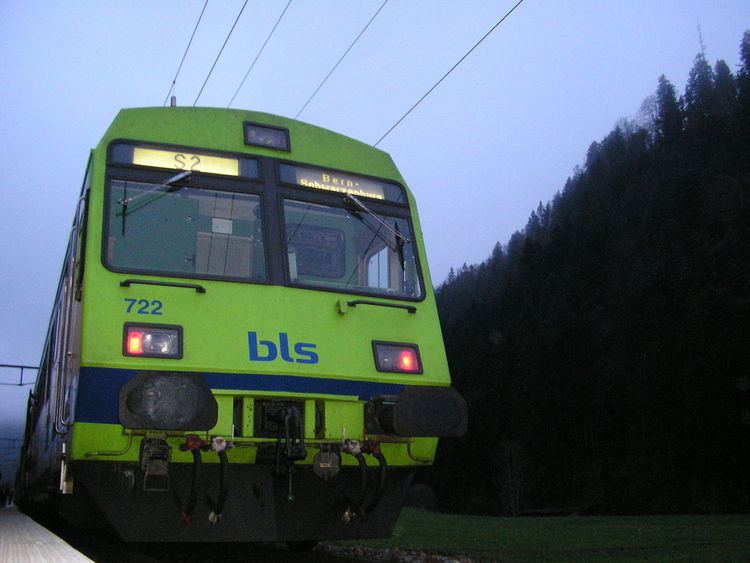The Bern S-Bahn (German: S-Bahn Bern; French: RER Berne) is an S-Bahn commuter rail network focused on Bern, the capital city of Switzerland. The network is roughly coterminous with Bern's urban agglomeration.
With approximately 9 million train kilometres per year, the Bern S-Bahn is the second-largest S-Bahn in Switzerland. It handles around 100,000 passengers daily (175,000 on weekdays), and thus carries the majority of the agglomeration's regional public transport traffic.
As early as 1974, Regionalverkehr Bern-Solothurn (RBS) began operating S-Bahn-style clock-face schedule services in the Bern area. Since 1987, the company has run a cross-city regional service between Thun and Laupen/Fribourg.
In 1995, RBS started to designate its regional services as S-Bahn services. The existing cross-city line was designated as S1, and the designation S2 was given to a new cross-city line, between Schwarzenburg and Trubschachen.
The next expansion occurred in 1997, with the commissioning of the S3 (Biel/Bienne−Belp) and the S4/S44 (Bern–Bümpliz Nord−Burgdorf and beyond). In addition, the remaining standard gauge regional train services were designated as the S33, S5, S51 and S55 lines.
Since the timetable change in December 2004, the RBS narrow gauge lines have been integrated into the S-Bahn numbering system as the S7, S8 and S9. Upon the 2008 timetable change, the network's interchange station arrangements were altered, the S11, S22 and S33 lines were shut down, and new lines S52 and S6 were opened.
The Bern S-Bahn Bern is operated, under a joint commission from the Canton of Bern, its neighbouring cantons and the Federal Government, by the following railway companies:
BLS AG (BLS);Regionalverkehr Bern-Solothurn (RBS).Upon the timetable change on 12 December 2004, the Swiss Federal Railways (SBB-CFF-FFS) withdrew from its previous involvement in the operation of the Bern S-Bahn, but also took over all of the long-distance services previously operated by the BLS.
As of 2012, the network consisted of the following lines:
S 1 Fribourg–Flamatt–Bern–Münsingen–ThunS 2 Laupen–Flamatt–Bern–Konolfingen–LangnauS 3 Biel/Bienne–Bern–Belp (from 21:00, replaces the S4/S44 as far as Thun)S 31 Supplements the S3 on Mondays to Fridays in the Münchenbuchsee–Belp section (since 11 December 2011)S 4 Langnau–Burgdorf–Zollikofen–Bern–Belp–ThunS 44 Sumiswald-Grünen–Ramsei–/(Solothurn–) Wiler–* Burgdorf–Bern Wankdorf–Bern–Belp–ThunS 5 Bern–Kerzers*–Neuchâtel/Murten (–Avenches–Payerne)S 51 Bern–Bümpliz Nord–BrünnenS 52 Bern–Rosshäussern–Kerzers (–Ins–Neuchâtel)S 6 Bern–SchwarzenburgS 7 Bern–Worblaufen–Bolligen–Worb DorfS 8 Bern–Zollikofen–Jegenstorf (from 21:30, replaces the RE as far as Solothurn)S 9 Bern–Worblaufen–UnterzollikofenNotes
The trains on line S 44 operate as two separate articulated train portions from (Solothurn–)Wiler to Burgdorf and from Sumiswald-Grünen to Burgdorf respectively, and are then combined into a multiple unit train from Burgdorf to Thun.The trains on line S 5 operate as a combined multiple unit train from Bern to Kerzers, and are then divided into two separate articulated trains, with one portion continuing to Murten (–Avenches–Payerne) and the other to Neuchâtel.Line S 52 operates outside peak times beyond its terminus at Kerzers through to Büren an der Aare. During peak times and in the evenings, S52 trains continue from Kerzers to Ins or Neuchâtel.The normal rolling stock rosters for the Bern S-Bahn are:
S 1 BLS RABe 525 ("NINA"): up to three units per train (max. 2 x 4-car + 1 x 3-car, due to limited platform lengths).S 2 BLS RBDe 565 ("NPZ") with two "B6 Jumbo" intermediate cars.S 3 BLS RBDe 565 ("NPZ") with intermediate cars comprising one "B6 Jumbo" and one B NPZ.S 31 BLS RBDe 565 as per S3.S 4 BLS RBDe 565 as per S3, or BLS RBDe 566 II ("NPZ") with "B6 Jumbo" intermediate car.S 44 BLS RABe 525 ("NINA").S 5 BLS RABe 525 ("NINA") and BLS RABe 535 ("Lötschberger") 1–3 units per train.S 51 BLS RABe 525 or BLS RABe 535.S 52 BLS RBDe 566 II.S 6 BLS RBDe 565 ("NPZ") with max. one "B6 Jumbo" intermediate car or BLS RABe 525 ("NINA") (weekends and evenings), and BLS RABe 535 ("Lötschberger") operating additional services in the mornings.S 7 RBS Be 4/12 ("Mandarinli"): in peak times 2 x 4/12 (4 rounds),S 7 supplementary trains Bern–Bolligen (2 rounds) Be 4/12 or ABe 4/12S 8 RBS Be 4/12 ("Mandarinli"): in peak times 4/12 + 4/8 (3 rounds)S 9 RBS Be 4/12 70 and 72 ("Secondas") or RBS Be 4/12 ("Mandarinli") (2 rounds) as replacements
